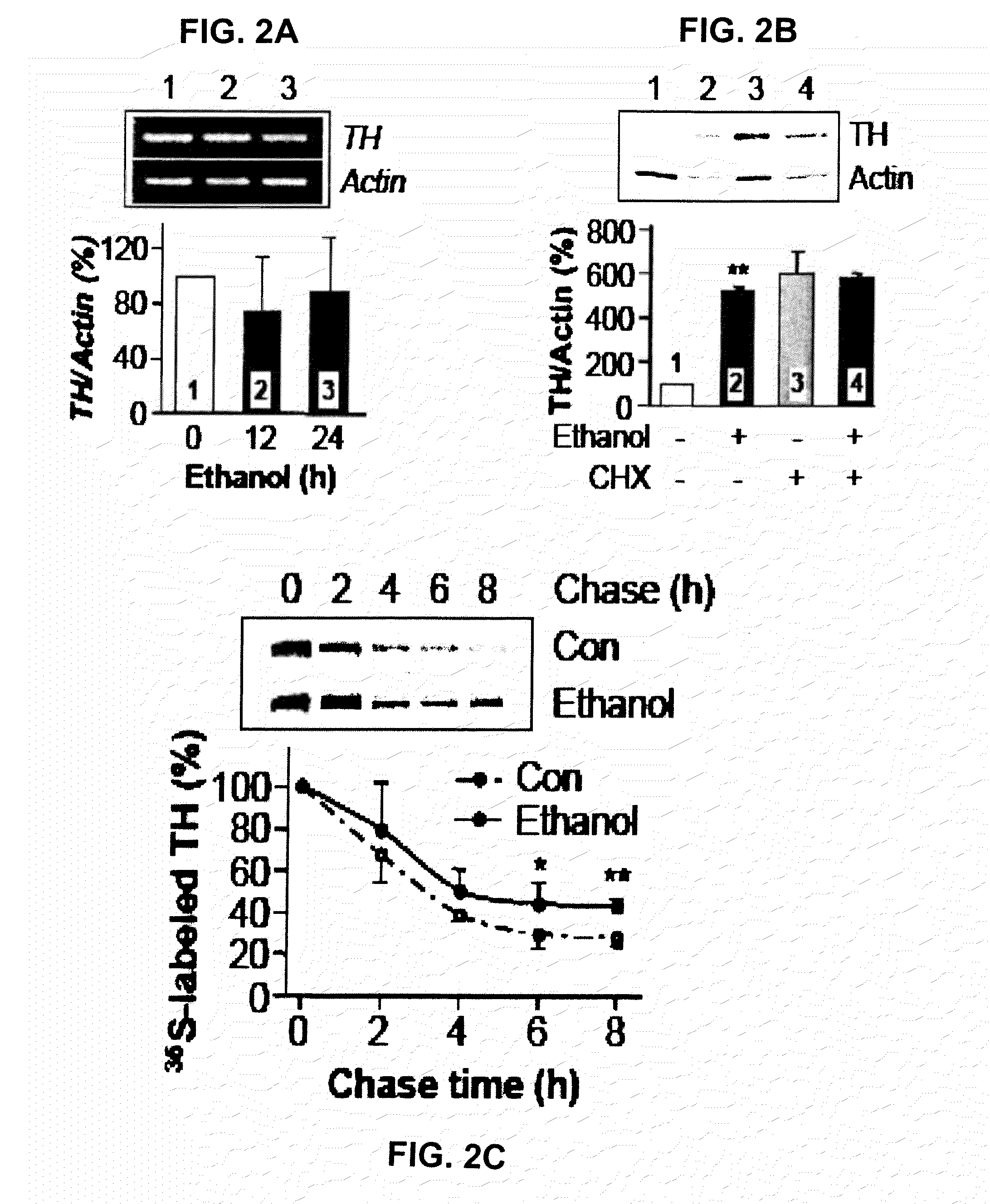Methods and compounds for treatment or prevention of substance-related disorders
a technology for substance-related disorders and compounds, applied in the field of methods of treating or preventing a substance-related disorder, can solve the problems of deteriorating effects on the living body, high cost to society, and difficult treatment of drug dependence, so as to reduce, inhibit or eliminate the effect of addiction-related behavior, and improve the effect of substance-related disorder. or eliminating the effect of the substance-related disorder
- Summary
- Abstract
- Description
- Claims
- Application Information
AI Technical Summary
Benefits of technology
Problems solved by technology
Method used
Image
Examples
example 1
Tyrosine Hydroxylase (TH) Immunoreactivity Level Upon Prolonged Exposure of Cells to Ethanol
[0347]The following example measured up-regulation of TH in cells upon prolonged exposure to ethanol.
[0348]Materials and Methods
[0349]Recombinant human GDNF polypeptide and anti-GDNF monoclonal neutralizing antibodies were purchased from R&D Systems. Bisindolylmaleimide I (Bis), PP2 and H89 were purchased from EMD Calbiochem. Phosphatase Inhibitor Cocktails 1 & 2, ibogaine-HCl, phosphatidylinositol phospholipase C (PI-PLC), cycloheximide (CHX), Rp-cyclic 3′,5′-hydrogen phosphorothioate adenosine triethylammonium salt (Rp-cAMPS) and anti-TH antibody were purchased from Sigma. Anti-heat shock protein 90αβ (HSP90) and anti-Actin antibodies were purchased from Santa Cruz Biotechnology. Anti-Akt1 / 2 antibody was purchased from Cell Signaling Technology. Protein G agarose was purchased from Invitrogen. Geldanamycin (GA) was purchased from Alexis Biochemicals. Redivue™ Pro-Mix™ L-[35S] in vitro Cell ...
example 2
Prolonged Exposure of Cells to Ethanol Enhances the Stability of TH Protein
[0359]The present example measured whether prolonged ethanol exposure induced an increase in transcription of the TH gene or synthesis of the protein.
[0360]For materials and methods please refer to Example 1.
[0361]It was found that prolonged incubation with ethanol did not increase TH mRNA (FIG. 2A). In addition, cycloheximide (CHX), a protein synthesis inhibitor, did not inhibit ethanol-mediated increases in TH protein levels (FIG. 2B). These results indicate that ethanol increases TH protein levels in a transcription- and translation-independent manner, suggesting that ethanol exposure may enhance the stability of the TH protein, resulting in its accumulation. To confirm our conclusion that prolonged exposure of cells to ethanol leads to the stabilization of the TH protein, we performed a pulse-chase analysis. After 24 h ethanol treatment, cells were labeled with 35S-methionine / cysteine and chased in normal...
example 3
Prolonged Ethanol Exposure Enhances TH Protein Stability Via Heat Shock Protein 90 (Hsp90)
[0363]The present example measured the influence of Hsp90 on the increase of ethanol mediated TH immunoreactivity.
[0364]For materials and methods please refer to Example 1.
[0365]To elucidate the mechanism by which ethanol increases TH protein stability, it was tested whether Hsp90 contributes to the ethanol-mediated increase in TH immunoreactivity. Hsp90 is a molecular chaperone that has extensively been shown to promote the stability and function of many signaling proteins (Zhang et al., J. Mol. Med. 2004, 82, 488-499). Specifically, Hsp90 enhances the stability of proteins by forming an ATP-dependent complex with proteins such as steroid receptors, epidermal growth factor receptor (EGF-R), Her-2, Akt, Raf-1 kinase, p53 and cdk4, protecting them from proteasome-dependent degradation (Zhang et al, supra; Pearl, et al., Annu. Rev. Biochem. 2006, 75, 271-294). Disruption of the complex of Hsp90 w...
PUM
| Property | Measurement | Unit |
|---|---|---|
| Disorder | aaaaa | aaaaa |
Abstract
Description
Claims
Application Information
 Login to View More
Login to View More - R&D
- Intellectual Property
- Life Sciences
- Materials
- Tech Scout
- Unparalleled Data Quality
- Higher Quality Content
- 60% Fewer Hallucinations
Browse by: Latest US Patents, China's latest patents, Technical Efficacy Thesaurus, Application Domain, Technology Topic, Popular Technical Reports.
© 2025 PatSnap. All rights reserved.Legal|Privacy policy|Modern Slavery Act Transparency Statement|Sitemap|About US| Contact US: help@patsnap.com



